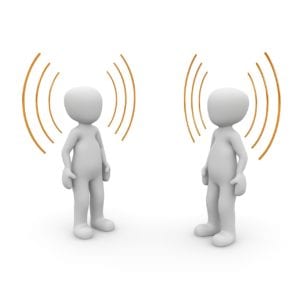 In reading casualty reports you will often see issues related to communications as a contributing factor. Miscommunications, lack of communications or too much radio traffic (to include overloaded radio channels) are often cited. It is the last of these issues I want to address. There is an inherent cognitive consequence from too much communications that can impact situational awareness. Essentially, you can stop listening. It doesn’t happen on purpose. Let me explain…
In reading casualty reports you will often see issues related to communications as a contributing factor. Miscommunications, lack of communications or too much radio traffic (to include overloaded radio channels) are often cited. It is the last of these issues I want to address. There is an inherent cognitive consequence from too much communications that can impact situational awareness. Essentially, you can stop listening. It doesn’t happen on purpose. Let me explain…
Visual learners
 When you are listening to an audible message, be that face-to-face, over the telephone or over the radio, your brain processes those audible messages into visual images. Essentially, the message comes into the ears via sound waves. The waves are transformed into electrical impulses in the auditory control center of your brain. Then the messages are sent on to the visual control center to be processed into a visual image.
When you are listening to an audible message, be that face-to-face, over the telephone or over the radio, your brain processes those audible messages into visual images. Essentially, the message comes into the ears via sound waves. The waves are transformed into electrical impulses in the auditory control center of your brain. Then the messages are sent on to the visual control center to be processed into a visual image.
For example, imagine you are talking to someone on the telephone about their recent vacation to the beach. In that conversation they vividly describe the pristine blue water and beautiful white beaches. Your brain processes the audible message and sends it on to the visual processing center where you will then formulate images of beautiful blue waters and white sand beaches, perhaps not unlike the image I have added here. We (humans) are visual learners.
Visual Processor Overload
 Problems with communications can occur when you are exposed to too much of it. Your brain becomes overloaded. When that occurs, bad things can happen. Think of your visual processor operating like the processor on your computer. [The two don’t, in reality, work anything alike, but let’s go with it for a moment.] When your computer processor reaches its capacity, it freezes up. If you’re on a PC, you get the hour glass. If you’re on a Mac, you get the gyrating psychedelic spinning wheel.
Problems with communications can occur when you are exposed to too much of it. Your brain becomes overloaded. When that occurs, bad things can happen. Think of your visual processor operating like the processor on your computer. [The two don’t, in reality, work anything alike, but let’s go with it for a moment.] When your computer processor reaches its capacity, it freezes up. If you’re on a PC, you get the hour glass. If you’re on a Mac, you get the gyrating psychedelic spinning wheel.
While the processor is at capacity, there is nothing else you can do but wait for it to get done. If you’re typing a document when the processor reaches capacity, the keyboard stops working. You can bang on it all you want and the characters are not going to show up on your document. Your processor is at capacity. Anything you try to enter at that point is not going to be processed. Let’s apply this example to your brain.
Your visual processing center, like your computer, also has limitations. When those limits are reached, it stops accepting new information. Your ears are still working fine. So is your audible processing center. But the visual center is overloaded. When that happens you get the proverbial cognitive hourglass (or spinning psychedelic wheel). Nothing else is getting in until the current load is cleared.
When there is a lot of radio traffic, it is easy for your visual processing center to get overloaded because there is so much information coming in. Unfortunately, unlike written information, there’s no shortcut to processing audible information. If you look at a written document, you can visually scan it and get right to the heart of what you want to know. Not so with audible information. You have to listen to it all. THEN and only then, can you determine what was important and what was not. But it still requires the full attention of your visual processor to make that determination.
Too much radio traffic
Excessive amounts of radio traffic can, therefore, inhibit your ability to process all of the information. Which information do you listen to and which do you discard (tune out)? Unfortunately, your brain’s not that good at deciphering and prioritizing. It’s a common misconception that a first responder will hear the critical radio traffic because the “stressed voices” of those who are in trouble will alert the listener. Seems plausible… until you evaluate how many times radio-transmitted maydays are missed the first time they are called.
Noise
Noise is the word given to sounds that have no cognitive value. Thus, radio traffic, or face-to-face communications for that matter, that do not provide essential information might be termed noise. How do you tune out the noise? The answer is, you can’t. Not consciously. However, your subconscious brain can tune it out. It’s a survival coping mechanism. But your brain does not, magically, let the important messages in and keep the unimportant messages out. It simply is not that efficient of a gatekeeper. If it were that talented, we’d all be better listeners, on and off the emergency scene.
The impact on situational awareness
Situational awareness begins with capturing clues and cues in your environment. Radio messages are among those clues and cues. If your brain has reached its cognitive capacity and cannot visualize audible messages, you are going to miss clues and cues. And when you do, your situational awareness will be flawed.
Sterile communications – a lesson from aviation

One way the aviation industry has dealt with excessive communications on the flight deck is by using a concept termed sterile flight deck. During the most critical segments of the flight (take-off and landings) pilots are not permitted to talk about anything that is not mission-critical.
This reduces the possibility of visual processor overload. Once the plane is safely on the ground or above 10,000 feet, the sterile flight deck rule is lifted.
Put it to the test
This concept is easy to test. Simply put three people in a room with a radio. Give the radio to one person and tell him or her it’s their job to listen to the radio and remember what is said. You can even let them write things down if they want. Put two other people in the room and have them carry on a loud conversation, including laughing, saying random unexpected things, and interrupting the radio listener several times during the exercise. During the exercise, use the radio to communicate seven scripted messages in succession, each about 20 seconds long and full of information (some important, some not). This simulates an emergency scene or the response to an emergency in an apparatus. When the exercise is done, give the radio listener a test and see how he or she does.
Then, make the environment sterile and repeat the exercise. No extraneous noise. You can use the same person and a new script or a new person and the same script. Compare the results. If the sterile environment resulted in just one more additional piece of information being remembered, that is huge because that one piece may be the mayday.
Rich Gasaway’s Advice
 For emergency services, the solution may come from aviation. Control the amount of audio messages coming into your brain and reduce the possibility of communications overload. One way to do this is to create a sterile communications environment. It starts from the time the call comes in and it does not end until the incident is stabilized (no one is operating in a hazardous environment).
For emergency services, the solution may come from aviation. Control the amount of audio messages coming into your brain and reduce the possibility of communications overload. One way to do this is to create a sterile communications environment. It starts from the time the call comes in and it does not end until the incident is stabilized (no one is operating in a hazardous environment).
This includes the elimination of all chatter in the apparatus while on the way to the call. If the communications is specific to the call, and important, it is shared. If not, save it until the incident is stabilized.
For radio communications, train personnel on what is important communications and what is noise. Practice communicating essential messages in short, concise ways. Long, extended radio diatribes are just added words the brain must process into meaning and it increases the potential for overload.
Team leaders and supervisors can reduce the impact of communications overload by having someone else listen to the radio on his or her behalf. While it may be a little uncomfortable at first, it can be very beneficial to have someone filter out all the noise and only tell the supervisor the need-to-know information.
Action Items
 1. Have you ever found yourself missing radio communications without realizing it?
1. Have you ever found yourself missing radio communications without realizing it?
2. Provide some examples of essential radio communications and how to say the messages concisely.
3. Provide some examples of non-essential radio communications (noise) that you have experienced.
_____________________________________________________

If you are interested in taking your understanding of situational awareness and high-risk decision making to a higher level, check out the Situational Awareness Matters Online Academy.
CLICK HERE for details, enrollment options and pricing.
__________________________________
Share your comments on this article in the “Leave a Reply” box below. If you want to send me incident pictures, videos or have an idea you’d like me to research and write about, contact me. I really enjoy getting feedback and supportive messages from fellow first responders. It gives me the energy to work harder for you.
Thanks,

Email: Support@RichGasaway.com
Phone: 612-548-4424
SAMatters Online Academy
Facebook Fan Page: www.facebook.com/SAMatters
Twitter: @SAMatters
LinkedIn: Rich Gasaway
YouTube: SAMattersTV
iTunes: SAMatters Radio

I think some get trained on a topic one time and they think they know it all… like taking it once is enough.
Les,
I agree with you completely. That is part of the misconception people have about how the brain works. They think learning it once is enough and then they never have to practice it or relearn it. That’s unfortunate because that’s a dangerous mindset.
Thanks for sharing.
Rich
hi , im from Colombia , i redaded this article and traslated to spanish then shared to my coworkers.
Very interesting read – I was wondering how I could get hold of a copy of this to print for my teams working in EOC’s